



© Brian Cross & UK DETECTOR NET 2025


OUT AND ABOUT IN SKIDMARK
IN THE FAST LANE FOR HAMMERED COINS
BY BRIAN & Mo’ CROSS
The Red Rocket was now dead, killed-off, derelict, kaput and lying in-state in the lay-by opposite our house. Parked next to the Rocket was our recent acquisition, Rocket II, a Talbot Express camper van, which was fully six years newer than the Rocket, and taller, faster and longer. We had bought it on a Tuesday and attended our club meeting on the Wednesday, where John Fargher, club President, had announced to cheers and cat calls, that Red Rocket was finally demised.
After quietening the cheering mob, John told the members that the new van was beige with a brown stripe and would be known as Rocket II, to keep the tradition going. Some Smart Alec quipped, “Why don’t you call it Skidmark?” This received huge applause and a great deal of laughter from the members, which prompted us to think that the idea of calling our new van “Rocket II” might already, be dead and buried.
The next day, loaded to the gunnels, Skidmark was flying down the motorway at a breath-taking 70 mph. Mo and Myself couldn’t believe it. Here we were passing vans, cars and lorries and travelling in the fast lane of the motorway, two lanes further to the right than we had ever travelled with the Red Rocket.
John Fargher had invited us to “The Goodall Institute”, as long as we took him there and back. Who could refuse an invitation like that? The three of us chatted and laughed through what proved to an uneventful, cheerful and speedy journey down to darkest Suffolk and the “Institute”.
Myself and Mo’ were caught totally unawares when we walked into the house and were greeted by two huge dogs that can only be described as ‘throw-backs’ from the age of the Dinosaurs. Well, surely that was the case, as these two were the biggest dogs we had ever seen. They made us feel like the ‘Little People’, especially when one put his front paws on Mo’s shoulders and started to lick the top of her head!
Me? As everyone knows I’m a bit of an urban cowboy, I’m just not into animals, none of them ever like me and the feeling is mutual. I swear that as these two beasts romped towards me, the whole of my past life flashed before my eyes! To be fair, the Irish Wolf Hounds soon settled down, once they had given Mo and myself’ a licking that beat a Turkish bath, hands down! The ‘Goodall Institute’ must be the only place in Britain where you can leave the TV and video on the back lawn and the cheque book on the back window sill and still sleep peacefully, for who would venture into a garden when the dogs peer over the 6ft fence to see what’s going on outside?
That evening John and his wife Kath, looked after us in a grand style. We partook in a bowl or two or Ipswich gruel, a green-looking mixture of broth with the addition of anything that John cares to find whilst out detecting. This was washed down with several bottles of Goodall Red Eye, a brew we felt John had concocted for the sole purpose of nobbling us the following day.
The only embarrassing point of the evening was listening to John Fargher and John Goodall, both addled on ‘Red Eye’, trying to take off the comedian Jethro. If we hear “What ‘appened wos” before the year 2010, it’ll be ten years too early. They bled the saying to death. On top of that JF started prancing around in only his boxer shorts, posing as Mr Universe, now that was a sight to make you cringe. Mo’ and myself made a dash for Skidmark and the peace that came with it.
The next day we awoke to the sun streaming into the van and the mercury rising very rapidly. It was going to be another scorcher. By 9 a.m. we were on site in Skidmark.
The field was large but rolled perfectly flat, ready for seed. John pointed out the various areas where items had come up. Hammered up the top, a bit of Roman from down there, a lovely Saxon strap-end from over there, etc, etc. We were off. An hour later I hadn’t had a signal of any note and met up with Mo’. She was doing as badly as I was. JF and John were in the distance plodding up and down; neither seemed to be doing any digging. “It’s gonna be one of those days”, we commented.
A further hour later we were collecting a bottle of water from Skidmark, as were the two John’s. The heat was almost unbearable; it was to be the hottest day we had ever detected in. By now we all had a few scraps of metal in our finds pouch and it was time something different popped up. The ground was baked hard and small sods of earth had to be gently hit with the trowel to crack them open to retrieve the signals. John said the weather had been this hot for a week.
Then I got a signal, looked down and saw the black edge of a large hammered coin. On picking it up, I found it was the badly damaged groat of Queen Mary, shown in Fig.1. This was the first Mary groat I had ever found, what a shame it was in this condition. This find spurred Mo and myself’ on. We all concentrated on the area of this find until dinner when we had a welcome break, sitting in the shade near Skidmark under some trees, listening to JF and John harking on about every subject under the sun and peppering every other sentence with the obligatory, “What ‘appened wos”. 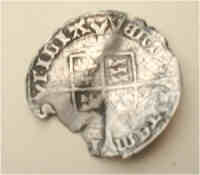
Battered Groat of Mary
Fig 1
The jokes were really flying and it was a shame to break the fun up with the drudgery of detecting in the searing heat.
A while later, I got a signal and picked up a small sod of earth ready to bash it with my trowel when I noticed something silver on the backside of it. It was a hammered quarter penny! It is shown in Fig 2. I haven’t identified the coin as yet because I am reluctant to take it out from the lump of baked earth. Every time I examine that lump of earth it reminds me of just how hot it was that day. This find fired us all up even though the day seemed to be getting even hotter. Mo’ wandered down to the very bottom of the field and went missing for several hours during which time both John’s got a scabby hammered each.
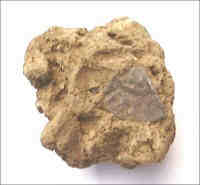
Baked soil with quarter hammered coin
Fig 2
I was just about to go back to Skidmark to brew up when I got a sweet signal and found the Elizabeth I half-groat shown in Fig 3. The day was drawing to a close now, it had been a good day for me finding three hammered coins, and I was quite content to brew up and relax in the van for the last half-hour. Slowly the others came back and we showed each other our finds. Five hammered coins had been found with nothing special in the artefacts section but what red faces and necks we all had. We all looked as if we had been bar-b-qued all day….. which we had.
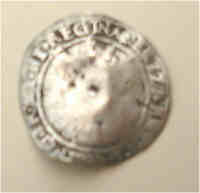
Elizabeth I half Groat
Fig 3
That night we all chilled out with a few beers and wines and talked detecting till the early hours of the morning. What is it about detecting that makes you do it all day long and talk about it the whole night through when you get back from a trip? We think it’s the adventure and excitement of the hobby. A bit like the old gold prospecting days. We can imagine the old 49’ers would have done exactly the same thing i.e. dug the pay dirt all day and then spent the night around the camp fire telling tales of how Old Pete hit the jackpot, etc.
We awoke early the next morning, bleary-eyed and red-faced. The two John’s were already awake, packing lunch and cracking jokes. Within half an hour, the sun already hot, Skidmark was blazing a trail to a field full of Roman influence that Mr Goodall had planned for us to search.
Unfortunately, this field was quite roughly ploughed and very, very dry. It was a big field with several long depressions in it. It was baking hot again and within an hour, with few signals, we were all very weary. Myself, Mo’ and John were a long way from home, we had travelled far to be here. These hard facts keep you going when, if you were near home, you would probably pack in and head off home, to sit out in the shade.
Then, all of a sudden, we could hear JF, hootin’ and hollerin’. He had found something,,,, something nice. Sure enough, he’s found a lovely groat, probably of Edward III. This spurred us all on with renewed enthusiasm.
By dinner Mo & myself’ just had a couple of crotal bells to show for our efforts. These are shown in Fig 4. Many people still say that we find loads of these ‘Up North’ but the fact is that every time we travel south we start to find crotal bells. We rarely find them when detecting in Cheshire, Lancs or Yorkshire. We were pleased with these two as they both had their clackers. The one on the left, found by Mo’, has a beautiful patina.
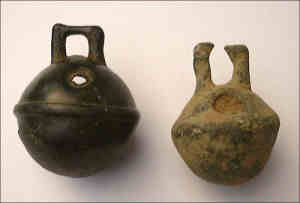
Crotal bells
Fig 4
After dinner John decided that we should try another field. This was in the middle of no-where; we had to trudge across several fields to get to it. By late afternoon we all had several grotty Roman bronzes and a couple of broken bits of Roman metalwork, including several fibulas’ between us, all broken. Then, Mo’ gave me a signal telling me that she had found a Roman silver. I made my way across to look at the denarius of Julia Domna, shown in Fig 5. It was well deserved and very welcome.
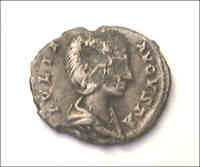
Denarius of Julia Domna
Fig 5
We were all pleased with this find, as between the four of us, two nice finds had now been unearthed during the day. Despite all feeling jaded, we took off again, as the heat slowly died down and the day grew welcoming cooler. No further finds of any note were made, except for three bags of apples grabbed by Mo' as we passed some apple trees.
That evening was going to be a quiet one, John told us as we drove back home. He planned to take us to a rally run by Ken Wilcox, Anglian NCMD Region rep. Ken, John Goodall and Martin Brunt run the East Coast Searchers. They run many rallies with the intention of attracting non-NCMD members into the fold. We would need an early start. “But, as it’s a lovely evening,” John told us, “we’ll have a Bar-B in the garden and chill-out.” The food was ready when we got back and went down well, as did the couple of bottles of Claret D’Ipswich. John produced a few more bottles and then some more. Slowly the evening turned to night and the night into early morning. That was one helluva good evening.
Somehow we all managed to awake and get dressed, that was the only requisite apart from the drivers who were on autopilot anyway. We arrived on site, paid our dues, shook hands with acquaintances we’d spoken to by phone and e-mail but had never met and then got our gear and began detecting, once again.
Three fields were available and slowly over the next few hours finds began to appear; “a hammered from over there, someone had a denarius, another hammered from the far corner of that field and a lovely buckle from the middle of that field.” Not a great number of finds for the people present but we accept that as par for the course on such events. The main thing was that everyone was enjoying themselves, money was being raised, the weather was lovely and there was always the chance of a nice find turning up.
Mo and myself’ worked the far side of the bigger of the three fields as rumour had it that there used to be several houses at the field edge. By early afternoon most detectorists were gathered by their cars, obviously having dinner or just resting and talking. We had found a lot of modern rubbish and the three buckles shown in Fig 6, the fact that these had turned up encouraged us to stay working this area rather than wander about a field we didn’t know anything about. 
Three buckles
Mo’ decided to walk back to the cars, the heat was getting her down and I had to admit that I was weary too. “I’ll be with you after a couple more strips,” I told her. I trudged on, up and down, occasionally looking up to discover that I was virtually the only person left detecting. As I finished each 200 yard strip I mentally noted how many signals I’d dug, “Two on the previous row, four on this row, one of the signals on the next row is going to be a beauty,” I told myself. Most rows produced a button or two or several Georgian coppers so signals were there. Unknowingly, I trudged on for almost two hours, and then I turned the soil over after a signal and saw a hammered groat Wow, what a kick I got from unearthing that coin!! Mo and myself’ often persevere on fields for one reason or another; sometimes it’s just a gut instinct. My feelings about his field had been proved right even if they had only been in my subconscious and I hadn't aired them to anyone.
The coin is shown in Fig 7 and is a groat of Henry VI First Reign 1422-1461, it is of the Rosette Mascle Issue 1427-1430. It has a fair bit of damage but is still a nice find. I was happy to head off back to Mo’ and the van for a rest and some dinner.
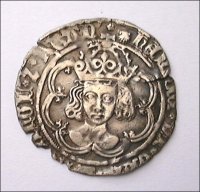
Henry VI Groat
Fig 7
When I got back to the car park, I discovered that a potato harvester had come onto the smaller field to gather the remainder of the crop in. A number of detectorists had got permission from the farmer to pick up the loose potatoes missed by the harvester. Martin Brunt, his wife Jo' and their young lad were picking spuds galore. The lad was passing piles to Mo’ who was stashing them into every nook and cranny in Skidmark. This was becoming a tradition i.e. coming back from a detecting trip loaded up with a couple of finds and a mass of fruit and veg!
rom this venue we said our goodbyes to John and the lads from the East Coast Searchers and intended to make our way to visit Jimmy Sierra and his USA visitors in Norfolk. We had spoken with several of them via e-mail for some time and promised that we’d try to meet them when they were in the UK. A quick phone call however saved us a wasted journey, for they had left for Kent the day before!
Now that we were not going to meet the lads from the USA we had one day to spare and decided that we would visit a farm in Norfolk, we had been to before. We were there just before dark, after booking J.F. in at a B & B.
We picked John up next morning and were on the fields by mid-morning. We had two fields available to us providing us with plenty of acreage on this last day of detecting. The weather was beautiful but still stifling hot. We chilled out a lot, had plenty of laughs and did a bit of detecting. It was here that JF found his dagger chape featured in one of his articles last year. It was a lovely find.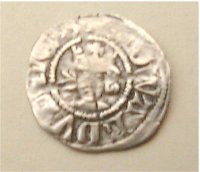
Fig 8
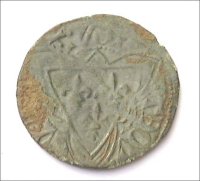
Penny Token or Jetton
Fig 9
After several hours I found the beautiful hammered half-penny shown in Fig 8. It is of Edward II, London mint, 1307-1327. Shortly after, the item shown in Fig 9 came up. We presume this to be an early token or counter and welcome opinions from readers of The Searcher.
Shortly before we packed in to head off on the long journey home, I got a signal which proved to be very difficult to find. I got it in the end after sifting handfuls of soil over and over again. It is shown in Fig 10a and 10b. It is a badly clipped half-penny which we believe comes from the reign of Henry VII, it is London mint.
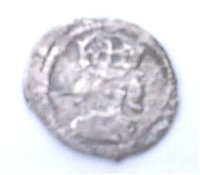
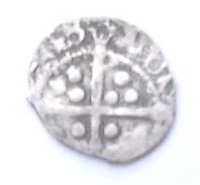
Fig 10a Fig 10b
Possible halfpenny of Henry VII
We arrived home safely after dropping off poor old JF who was completely knackered. Jaw ache was his chief burden, ‘detecting arm’ coming a far second.
Joking besides we had a wonderful time and thank John & Kath for their hospitality. The new van Skidmark performed without a hitch and got us to our destination in record time, travelling in the fast lane to give us hammered coins.